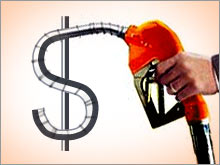|
$3-plus for gas, but we keep buying more Americans are likely to use more fuel than ever this summer, despite record-high prices.
(Fortune) -- If anyone ever questioned America's love affair with the automobile or our willingness to pay up for gasoline, this summer should remove all doubt. Despite record-high gas prices that seem relentless - $3.13 a gallon in New York, $3.23 in L.A. and Chicago - Americans are on track to burn through more fuel this summer than ever. Even though the average cost of a gallon of gas is 25% higher than it was a year ago, Americans in the last four weeks have consumed 140,000 barrels more a day, a 1.5% increase from last summer's 9.4 million barrels. I'll be the first to admit that I thought $3-a-gallon gas might be the tipping point, but it's just not the case, according to the experts.
"We just don't see any price response yet," says David Kirsch, who tracks gasoline for PFC Energy, a Washington-based consulting firm. "The American consumer never ceases to amaze us with their willingness to pay more for gasoline." Although pain at the pump has hit sales of SUVs and the L.A. Times is reporting that people are eating out less as a result, it looks like it will take far higher prices to force a fundamental shift in driving habits or make people consider alternatives like public transportation. That's one reason why Congress and the White House should be encouraging consumers to change their habits - whether by increasing support for public transportation, taxing gas guzzlers, or providing incentives for alternative-energy and fuel-efficient cars. Unfortunately in this election year, politicians in both parties would rather talk about expanding offshore drilling than asking voters for even a small sacrifice in terms of their behavior. What's more, gasoline has always been what economists term 'price inelastic' - in other words, consumer demand isn't affected much by price increases, at least in the short-term. Over the long term, correlation between demand and price for gasoline is -.05, according to Larry Goldstein of PIRA Energy, an international energy-consulting firm, which means for every 20% increase in price, consumption only drops 1%. "Gasoline is the most price-inelastic of the petroleum products," he says. "Poor consumers have already felt the pain and adjusted their habits. For other consumers to make changes, you'd need a much bigger price increase." "The product is a necessity," Goldstein adds. "About 85% of us go to work by car, and a lot of people don't have a choice. Where it comes back and bites is that demand for everything else goes down." That spells more pain for mass retailers like Wal-Mart (Charts) and - investors take note - other consumer discretionary plays like restaurant chains. Meanwhile, a big winner is likely to continue to be Valero, the nation's biggest independent refiner. Last week, Valero (Charts) reported second-quarter earnings of $1.9 billion, up from $843 million a year ago, and predicted the third-quarter would be another show-stopper. Indeed, Valero has been benefiting from strong refining margins, and fears of another bad hurricane season are likely to push its shares higher. That's one reason why Valero stock closed at $66.20 Friday, not far from its 52-week high of $70.75. Other oil stocks, like BP (Charts), Exxon (Charts), and Chevron (Charts) tend to trade according to the ups and down of crude, so if you're a gasoline bull, stick with Valero. For consumers and the broader economy, about the only good thing that can be said about the run-up in gas prices is that the timing could have been much worse. "There's low unemployment, good economic growth and both salaries and disposable income are both growing at more than 3% annually," says Goldstein. That's very different from the oil shocks of the 1979 or 1990, when a surge in energy prices pushed an already fragile economy over the edge. ---------------------------------------- |
|

